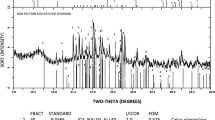Abstract
The effects of shape, age and curing on conversion factors were investigated for a series of nine lightweight concretes (LC) and one normal weight concrete (NC) covering the strength range from 15 to 70 MPa. The experimentally obtained conversion factors between standard cylinders and cubes (1.17 to 1.26) correlate much better with the factor given for NC (1.23) in Model Code 90, EN 1992 and EN 206 than with the one for LC (1.10). This may result in an overestimation of the strength class, if cubes are tested only as it is common in e.g. Austria and Germany. The question arises, if deviating conversion factors for LC are needed at all. The experimental findings will be explained by means of the by lightweight aggregate determined strength limit (f lc,lim) and changes in crack pattern in the course of the hydration. The conversion factor for NC is the better fit as long as the strength of lightweight aggregate is not the limiting factor. Above this limit the conversion factor decreases and approaches the one given for LC in EN 1992. In practice, this will only apply for a few LC. The conversion factor between water storage and dry curing is the same for LC and NC.
Access this chapter
Tax calculation will be finalised at checkout
Purchases are for personal use only
Similar content being viewed by others
References
Bachmann, H.: Konstruktiver Leichtbeton. ETH Zürich, Basel (1973)
Bonzel, J.: Die Gestaltabhängigkeit der Betondruckfestigkeit. Beton- und Stahlbetonbau 54(9, 10), 223–228, 247–248 (1959)
BS 8500-2: Concrete. Complementary British Standard to BS EN 206. Specification for constituent materials and concrete (2015)
CEB-FIP: Model Code 90, Thomas Telford Services Ltd. (1991)
CUR Research Committee C 75: Structural behaviour of concrete with coarse lightweight aggregate. Gouda, The Netherlands, Centre for Civil Engineering Research and Codes (1999)
DIN EN 206: Concrete - Specification, performance, production and conformity (2013)
DIN EN 1992-1-1: Eurocode 2: Bemessung und Konstruktion von Stahlbeton- und Spannbetontragwerken – Teil 1-1: Allgemeine Bemessungsregeln und Regeln für den Hochbau (2011)
DIN EN 1992-1-1/NA: Nationaler Anhang - National festgelegte Parameter - Eurocode 2: Bemessung und Konstruktion von Stahlbeton- und Spannbetontragwerken – Teil 1-1: Allgemeine Bemessungsregeln und Regeln für den Hochbau (2013)
Elwell, D.J., Fu, G.: Compression Testing of Concrete: Cylinders vs. Cubes, New York State Department of Transportation (1995)
Erlien, O.: Heidrun TLP. Utilization of high strength LWA-concrete. In: Holand, I., Hammer, T.A., Fluge, F. (eds.) International Symposium on Structural Lightweight Aggregate Concrete, Sandefjord, Norge, NCA, pp. 337–348 (1995)
Faust, T.: Leichtbeton im Konstruktiven Ingenieurbau. Ernst & Sohn, Berlin (2003)
Gjerde, T.: Structural Lightweight-Aggregate Concrete (LWA-Concrete) for Marine and Offshore Applications, Norwegian Contractors (1982)
Herrnkind, V., Scholz, S.G.: Berücksichtigung des Einflusses der unterschiedlichen Lagerungsarten “trocken” und “feucht” auf die Ergebnisse der Druckfestigkeitsprüfungen. Beton 58(4), 164–167 (2008)
NBN B 15-001: Concrete - Specification, performance, production and conformity + Belgian supplement to NBN-EN 206 (2012)
NEN-EN 206 + NEN 8005 nl: Concrete - Specification, performance, production and conformity + Dutch supplement to NEN-EN 206 (2016)
Neville, A.M.: A general relation for strengths of concrete specimens of different shapes and sizes. J. Am. Concr. Inst. 63(10), 1095–1110 (1966)
Nicolay, J., Dornauer, H.: Prüfverfahren im Vergleich – Einflüsse bei der Bestimmung der Betondruckfestigkeit. Beton 42(7), 384–387 (1992)
ÖNORM B4710-1: Beton Teil 1: Festlegung, Herstellung, Verwendung und Konformitätsnachweis (2007)
Reinsdorf, S., Kühne, G.: Hochfeste konstruktive Leichtbetone - Formänderungs- und Festigkeitskennwerte. Schriftenreihe der Bauforschung Reihe Stahlbeton 20, 55 (1972)
Siebel, E., Wischers, G.: Verformungsverhalten und Energieaufnahme von Normal- und Leichtbeton im Kurzzeitdruckversuch. Beton 39(7, 8), 303–307, 341–346 (1989)
Silva, A., Soares, A., Flores-Colen, I., de Brito, J.: Mechanical characteristics of lightweight mortars on small-scale samples. J. Test. Eval. 44(1), 402–413 (2016)
Sim, J.-I., Yang, K.-H., Kim, H.-Y., Choi, B.-J.: Size and shape effects on compressive strength of lightweight concrete. Constr. Build. Mater. 38, 854–864 (2013)
Thienel, K.-C.: Materialtechnologische Eigenschaften der Leichtbetone aus Blähton. In: Geburtstag von Prof. Dr.-Ing, Rostásy, F.S. Schmidt-Döhl, F. (eds.) Baustoffe in Praxis, Lehre und Forschung: Festschrift zum 65, pp. 203–210. Wilhelm Ernst & Sohn, Braunschweig (1997)
Thienel, K.-C.: “CTPOИTEЛЬCTBO ИЗ ЛEГКOГO БETOHA: OT CBOЙCTЬ MATEPИAЛA ДO PEAЛИЗAЦИИ B COOPУЖEHИЯX (Bauen mit Leichtbeton - Von den Eigenschaften zur Umsetzung).” бeтoн и жeлeзoбeтoн (Beton und Stahlbeton) 2(7), 110–115 (2012)
UNESCO: Reinforced Concrete: An International Manual, London (1971)
Weigler, H., Reißmann, K.: Untersuchungen an Konstruktions-Leichtbeton. Mitteilungen aus dem Institut für Massivbau. Darmstadt, TH Darmstadt. 8, 106 (1965)
Author information
Authors and Affiliations
Corresponding author
Editor information
Editors and Affiliations
Rights and permissions
Copyright information
© 2018 Springer International Publishing AG
About this paper
Cite this paper
Thienel, KC. (2018). Verification of Conversion Factors Used for Compressive Strength Values Obtained for Structural Lightweight Concrete. In: Hordijk, D., Luković, M. (eds) High Tech Concrete: Where Technology and Engineering Meet. Springer, Cham. https://doi.org/10.1007/978-3-319-59471-2_188
Download citation
DOI: https://doi.org/10.1007/978-3-319-59471-2_188
Published:
Publisher Name: Springer, Cham
Print ISBN: 978-3-319-59470-5
Online ISBN: 978-3-319-59471-2
eBook Packages: EngineeringEngineering (R0)



